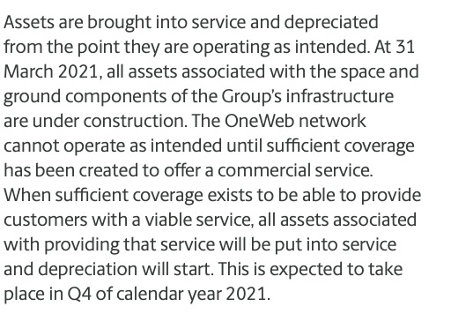
What's the cost of a #OneWeb satellite? A thread.
Yesterday at a round table, one of my co-panelists, Chris McLaughlin of @OneWeb reacted to my talk on constellation economics with a statement: "a OneWeb satellite cost 1,2M$". Now, what do the financial statements say?
1/
Yesterday at a round table, one of my co-panelists, Chris McLaughlin of @OneWeb reacted to my talk on constellation economics with a statement: "a OneWeb satellite cost 1,2M$". Now, what do the financial statements say?
1/
In order to double check the statement I have pulled down @OneWeb's financial statements and have looked at the value of property (as from March 2021).
oneweb.net/assets/news/me…
2/
oneweb.net/assets/news/me…
2/

The "space component under construction" is worth 1046M$. We also learn that the satellites already in orbit are considered under construction and will not be depreciated 'until sufficient coverage has been created to offer a commercial service'.
3/

3/


This is unusual. It does not recognise the fact that satellites start depreciating right after launch. With the first satellites in orbit for more than two years I would assume that a lot of the useful lifetime is already gone for them (>100 satellites are >1 year old today).
4/
4/
So the question arising is: how many satellites are included in the 1046M$ figure? If we assume a total count of 650 satellites, the unit cost in orbit is 1,6M$ (launch included). If the original statement is right that would mean that the launch value per satellite is 400k$.
5/
5/
But we can't be sure that the value of 650 satellites was recognised as assets, unless the Oneweb factory has produced all of them. The only sure thing is that by March 2021 there were 114 satellites in orbit. How many more could have been recognised as 'under construction'?
6/
6/
Is a figure of 500+ satellites in construction plausible? Would it be relevant (GAAP compliant) to value them at full cost? The Financial Statements don't provides these details, so let's make two assumptions.
7/
7/
Assumption 1 (optimistic): Oneweb has already charged the full value of 650 satellites (including launch) to "assets under construction". The unit cost would be 1046/650=1,6M$ per unit. That is about 8k$/kg for spacecraft and 2,6k$/kg for launch (see 5/). This is very cheap.
8/
8/
Let me note that the satellites were launched by Soyuz from Baikonur under the Arianespace flag, with 100% Russian operations. Each launch is about 5 tons, so at the best street price for Soyuz (35M$), I'd expect the launch price to navigate around 5-7k$/kg, not 2,6$/kg.
9/
9/
Assumption 2 (conservative): there would be about 250 satellites under construction in March 2021 (i.e. the ones in plan for launch in 2021). In this case the unit cost is 1046/360=2,9M$/satellite, or about 20k$/kg in orbit, launch included (or 13-15k$/kg launch excluded).
10/
10/
With assumption 1 the total deployment cost of the constellation would be in the range of 1,2B$. Annual Capex requirements would sit at 200-250M$/year.
With Assumption 2 the total deployment cost would be 1,8B$, and annual Capex would be 360M$/year.
11/
With Assumption 2 the total deployment cost would be 1,8B$, and annual Capex would be 360M$/year.
11/
Caveat: neither assumption considers the costs of R&D nor the costs of the factory in Florida. Are this costs 100% borne by the manufacturing subsidiary? Maybe, but they do exist in reality. So there may be 2B$ (20k$/kg) to add to the real cost of the constellation?
12/
12/
So what's my take on this? If (1) is correct Oneweb has demonstrated the capacity to lower the cost of space infrastructure to a mere 8k$/kg (launch incl.) which puts it close to Starlink stated cost targets (2k$/kg), and way below current TLC satellite costs (50-60 k$/kg).
13/
13/
If assumption 2 is correct the cost structure of Oneweb is less attractive, at 20 k$/kg, i.e. in the unsustainable range for LEO Broadband constellation (as discussed in a previous post).
14/
https://twitter.com/LionnetPierre/status/1448678082609664005
14/
In both cases, if we include in the cost equation the 2-3B$ of pre-chapter11 investment, the cost of the satellite infrastructure is utterly unsustainable at 30-40k$/kg (as discussed in a previous post).
15/
https://twitter.com/LionnetPierre/status/1448678082609664005
15/
Takeaway: each Oneweb satellite probably costs between 1,6M$ and 3M$ to build & launch. This bargain value does not include the costs of development nor production facilities. The low cost is also made possible by a very good launch price (estimated at 5k$/kg or below).
16/
16/
PS: The satellites are built by a subsidiary co-owned with Airbus. The sub registers the cost of assets to build the satellites. It is not clear whether the sub had paid for R&D. In this case the mother company only suffered from 50% of the sub losses (pro rata to its share).
17/
17/
PS2: At 5k$/kg to LEO, Soyuz matches the Falcon 9 pricing for rideshare, and is probably a strong competitor for LEO launch of commercial payloads. But is there even room for a profit for Arianespace?
18/
18/
PS3: I didn't include an assumption 3 where the 1046M$ account only for the sats in orbit in March 2021 (114). It would put each satellite at 9M$ (60k$/kg)... this would be an 'oldspace' price.
19/
19/
PS4: I would very much like to see the financials of Airbus-Oneweb Satellites LLC, the company that builds the satellites. Maybe some info in Airbus AR for 2021?
20/

20/


PS5: And I would also very much like to know how much capital was wiped out by theChapter 11 procedure. Feel free to DM if you're willing to share details.😎
21/
21/
Follow up: if this is true (1B$ contract with Arianespace), then each satellite launch is valued at 1,5M$ (or 10k$/kg). Clearly beyond sustainability... spaceflightnow.com/2015/07/01/one…
• • •
Missing some Tweet in this thread? You can try to
force a refresh













